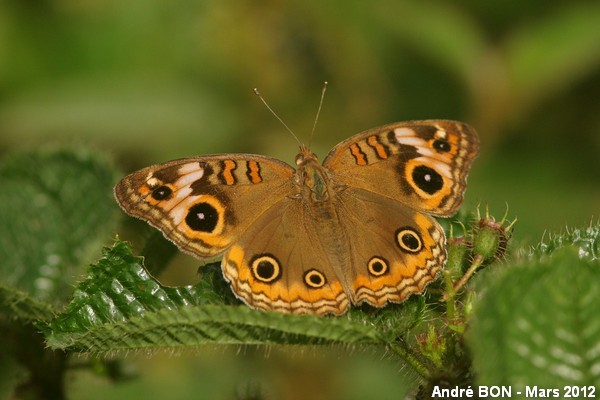
| Tropical Buckeye (Junonia genoveva (Cramer, 1780)) |

|
|
Scientific name: Junonia genoveva (Cramer, 1780) Common name: Tropical Buckeye French name: Junonia genoveva Order: Lepidoptera Suborder: Rhopalocera Family: Nymphalidae Subfamily: Nymphalinae Wingspan: 35 to 57 mm. Biotope: Open habitats, mangroves. Geographic area: Central America, South America, the Caribbean. Flight time: All year round. Number of generations : Three or four broods per year in the northern part of the range, maybe more further south. Caterpillar: Blackish with tiny pale spots and scoli with metallic blue sheen on the upper side and with reddish orange scoli on the under side. Host plant: Populations near the sea grow on Black Mangrove (Avicennia germinans) of the Acanthaceae family. Inland populations grow on other plants of the Acanthaceae family or of the Verbenaceae family. |
Junonia genoveva has copper brown wings bordered with thin lines on the margin. Two short copper reddish bands cross half of the fore wings starting from the costal edge. They are followed by a broad pinkish white band running in diagonal from the costal edge to the margin. The fore wings show two black white-pupiled ocelli, both ringed with orange, a small one near the apex and a large one touching the white band in the submarginal area. The hind wings show two black ocelli ringed with orange. They clearly differ in size. The under side of the wings is dark beige. It shows the same ocelli and white band as the upper side. Junonia genoveva and Junonia evarete are very similar and were often confused. They are not very easy to differentiate. The white band is reduced next to the large eyespot on Junonia evarete and it does not extend to the wing margin. There is less difference of size between the two eyespots on the hind wings (maximum 1/3). However the most reliable criteria to tell both species apart is based on the colour of the under side of the antennae. The under side of the antennae is black at the tip and then pale on Junonia genoveva. On Junonia evarete the under side of the antennae is variable in colour but does not show any important contrast between the tip and the remaining part of the antenna. |
| [To know more about the Tropical Buckeye] [Top] |

|
I have shot this picture along the footpath starting from the Communal Hut on the Track of Sainte Élie. The white subapical band on the fore wings seems to reach the margin. The ocelli on the hind wings really differ in size. I have measured the diameter of the ocelli on the picture. I have calculated the two surface areas and then I have divided the difference of the two surface areas by the surface area of the largest ocellus. Then I get the difference of surface of the two ocelli relatively to the surface area of the largest one, here 40%. I have read that a value below 33% is an indication for the Junonia evarete species and a value above 33% is an indication for Junonia genoveva. However I don't know if I have used the correct calculation method, nor if this is applicable to all subspecies. Furthermore I do not have any precise information about the relevance of this criteria ... On the non-reduced picture it seems that the club of the antenna is black on the underside on a short length and then the remaining part of the antenna is a light colour. Everything fits to tell this specimen as Junonia genoveva. |